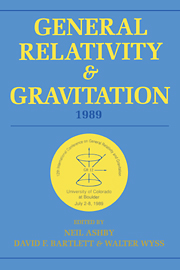 General Relativity and Gravitation, 1989
General Relativity and Gravitation, 1989 Book contents
- Frontmatter
- Contents
- Preface
- Conference committees
- Part A Classical relativity and gravitation theory
- WORKSHOPS
- Part B Relativistic astrophysics, early universe, and classical cosmology
- WORKSHOPS
- Part C Experimental gravitation and gravitational wave detection
- WORKSHOPS
- C1 Solar system and pulsar tests of gravitation
- C2 Earth-based gravitational experiments
- C3 Resonant bar and microwave gravitational wave experiments
- C4 Laser gravitational wave experiments
- Part D Quantum gravity, superstrings, quantum cosmology
- WORKSHOPS
- Part E Overviews-past, present, and future
C3 - Resonant bar and microwave gravitational wave experiments
Published online by Cambridge University Press: 05 March 2012
- Frontmatter
- Contents
- Preface
- Conference committees
- Part A Classical relativity and gravitation theory
- WORKSHOPS
- Part B Relativistic astrophysics, early universe, and classical cosmology
- WORKSHOPS
- Part C Experimental gravitation and gravitational wave detection
- WORKSHOPS
- C1 Solar system and pulsar tests of gravitation
- C2 Earth-based gravitational experiments
- C3 Resonant bar and microwave gravitational wave experiments
- C4 Laser gravitational wave experiments
- Part D Quantum gravity, superstrings, quantum cosmology
- WORKSHOPS
- Part E Overviews-past, present, and future
Summary
In the 20 years after Weber's first publications there have been yearly announcements of new, better ways to detect the signals that everyone knows must be there. Drever, Billing, Douglass and Tyson, Garwin and Levine all built detectors that were of better sensitivity than that estimated by Weber in his original papers. None of those experiments were able to verify Weber's results. In almost every meeting of the past 20 years there have been the promises of the potential of the “second generation” detectors: cryogenic detectors using superconducting instrumentation that would be so sensitive that they would be able to see signals from as far away as the Virgo cluster. In many such meetings for the last 10 years these reports of the potential sensitivity have been tempered by descriptions of the experimental difficulties that were temporarily delaying the attainment of that sensitivity.
The exciting thing about this meeting was that–while there were still tales of wonders to come and of the experimental difficulties that some detectors were confronting–we also had reports of coordinated runs between groups looking for coincidental excitation of their antennas. We had informal meetings outside of the workshops to coordinate data taking and exchange of data. In short, this workshop was the first meeting where three or more groups were confident enough about their detectors that they could talk of coordinating their experiments and of coordinating their existing experiments with the upcoming third generation resonant bar detectors.
- Type
- Chapter
- Information
- General Relativity and Gravitation, 1989Proceedings of the 12th International Conference on General Relativity and Gravitation, pp. 349 - 356Publisher: Cambridge University PressPrint publication year: 1990
- 2
- Cited by
